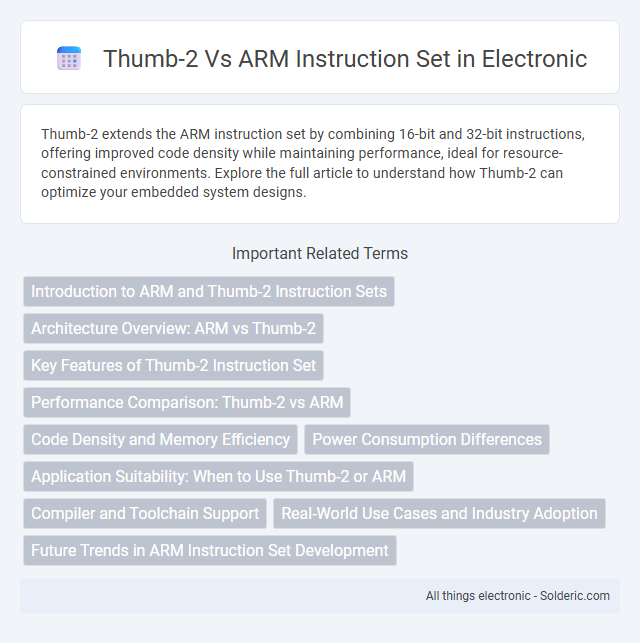Thumb-2 extends the ARM instruction set by combining 16-bit and 32-bit instructions, offering improved code density while maintaining performance, ideal for resource-constrained environments. Explore the full article to understand how Thumb-2 can optimize your embedded system designs.
Comparison Table
| Feature | Thumb-2 | ARM Instruction Set |
|---|---|---|
| Instruction Length | Mixed 16-bit and 32-bit | 32-bit fixed |
| Code Density | Higher code density, optimized for embedded systems | Lower code density, larger code size |
| Performance | Near ARM performance with reduced memory footprint | Maximum performance on ARM cores |
| Complexity | Moderate complexity due to mixed instruction sizes | Simpler fixed-length instruction decoding |
| Application | Embedded systems, low power devices | General-purpose computing, performance-critical applications |
| Backward Compatibility | Compatible with Thumb and ARM state switching | Original ARM architecture, no Thumb support |
Introduction to ARM and Thumb-2 Instruction Sets
ARM architecture supports two primary instruction sets: ARM and Thumb-2, designed to balance performance and code density. Thumb-2 extends the original Thumb instruction set by mixing 16-bit and 32-bit instructions, enabling more efficient memory use while maintaining the computational power of the full 32-bit ARM instruction set. Your choice between ARM and Thumb-2 depends on whether you prioritize higher execution speed or optimized application size.
Architecture Overview: ARM vs Thumb-2
Thumb-2 is an enhanced instruction set architecture that extends the original 16-bit Thumb instruction set by incorporating both 16-bit and 32-bit instructions, enabling improved code density and performance compared to the traditional ARM instruction set, which exclusively uses 32-bit instructions. ARM architecture provides a comprehensive set of 32-bit instructions designed for high-performance applications, whereas Thumb-2 offers a balance by maintaining compatibility while optimizing memory usage and execution efficiency. The hybrid nature of Thumb-2 allows seamless switching between 16-bit and 32-bit instructions, enhancing flexibility and enabling developers to optimize for both speed and code size within ARM processors.
Key Features of Thumb-2 Instruction Set
Thumb-2 instruction set combines 16-bit and 32-bit instructions to provide improved code density and performance compared to the original ARM instruction set, allowing better utilization of memory and enhanced execution speed. It supports advanced features such as conditional execution, bit manipulation, and extended addressing modes, enabling more efficient and flexible coding for embedded systems. Your applications benefit from reduced memory footprint and increased processing efficiency when leveraging the Thumb-2 instruction set architecture.
Performance Comparison: Thumb-2 vs ARM
Thumb-2 instruction set delivers enhanced code density with performance closely aligned to the ARM instruction set, making it ideal for memory-constrained applications. While ARM offers full 32-bit instructions enabling maximum execution speed, Thumb-2 combines 16-bit and 32-bit instructions to balance speed and efficiency. Your choice between Thumb-2 and ARM directly impacts application performance, especially in power-sensitive or real-time systems where instruction throughput and memory usage are critical.
Code Density and Memory Efficiency
Thumb-2 offers superior code density compared to the traditional ARM instruction set by combining 16-bit and 32-bit instructions, reducing memory footprint and enhancing execution efficiency. This compact instruction format leads to improved memory usage, making it ideal for embedded systems with limited resources. Your applications can benefit from faster fetches and lower power consumption due to the optimized Thumb-2 instruction encoding.
Power Consumption Differences
Thumb-2 instruction set reduces power consumption by enabling denser code, which minimizes memory accesses and improves cache efficiency compared to the traditional ARM instruction set. The shorter 16-bit Thumb-2 instructions lead to fewer fetch cycles, directly lowering dynamic power usage in embedded systems. You can achieve enhanced battery life and energy efficiency in your ARM-based devices by leveraging the Thumb-2 instruction set's optimized power profile.
Application Suitability: When to Use Thumb-2 or ARM
Thumb-2 instruction set is ideal for embedded applications requiring code density and low memory usage, such as IoT devices and wearable technology, due to its mixed 16-bit and 32-bit instruction encoding. ARM instruction set suits performance-critical applications like high-end smartphones and tablets, offering more straightforward, 32-bit instructions for faster execution and comprehensive operation support. Developers choose Thumb-2 for energy-efficient, compact code in resource-constrained environments, while ARM is preferred for maximum processing power and complex computational tasks.
Compiler and Toolchain Support
Thumb-2 extends the original Thumb instruction set by mixing 16-bit and 32-bit instructions, enabling more efficient code density and performance on ARM processors. Modern compilers like GCC and LLVM provide robust support for Thumb-2, offering advanced optimization techniques that leverage its variable-length instruction encoding to generate compact yet high-performance binaries. Toolchains continuously update to improve debug capabilities, instruction scheduling, and register allocation specifically tailored to the nuances of Thumb-2, enhancing both development efficiency and runtime execution quality.
Real-World Use Cases and Industry Adoption
Thumb-2 instruction set offers enhanced code density and improved performance, making it ideal for embedded systems in automotive control units and consumer electronics, where memory efficiency is critical. ARM's full 32-bit instruction set is widely adopted in high-performance applications such as smartphones, tablets, and servers, enabling extensive software ecosystems and advanced operating systems support. Major industry players, including ARM Holdings partners and semiconductor manufacturers, leverage Thumb-2 for IoT devices and wearable technology due to its balance between performance and reduced power consumption.
Future Trends in ARM Instruction Set Development
Future trends in ARM instruction set development emphasize increased efficiency, enhanced support for machine learning, and improved security features. ARM continues to evolve Thumb-2 to balance code density with performance, making it ideal for embedded and IoT applications where memory and power are limited. Your choice between Thumb-2 and other ARM instruction sets should consider upcoming enhancements that prioritize AI acceleration and energy efficiency.
Thumb-2 vs ARM instruction set Infographic

 solderic.com
solderic.com